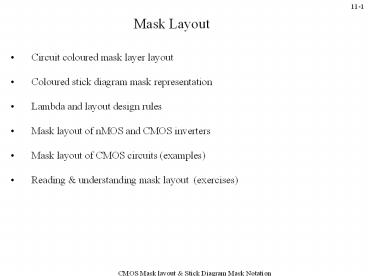11-* Mask Layout Circuit coloured mask layer layout Coloured - PowerPoint PPT Presentation
1 / 25
Title:
11-* Mask Layout Circuit coloured mask layer layout Coloured
Description:
11-* Mask Layout Circuit coloured mask layer layout Coloured stick diagram mask representation Lambda and layout design rules Mask layout of nMOS and CMOS inverters – PowerPoint PPT presentation
Number of Views:160
Avg rating:3.0/5.0
Title: 11-* Mask Layout Circuit coloured mask layer layout Coloured
1
Mask Layout
- Circuit coloured mask layer layout
- Coloured stick diagram mask representation
- Lambda and layout design rules
- Mask layout of nMOS and CMOS inverters
- Mask layout of CMOS circuits (examples)
- Reading understanding mask layout (exercises)
2
nMOS transistor mask representation
polysilicon
metal
Contact holes
diffusion (activeregion)
3
Mask layout coloured stick diagram notation
Silicon layers are typically colour coded as
follows This colour representation is
used during mask layer definition Translation
from circuit format to a mask layout (and
vice-versa) is relatively straightforward Several
examples follow
diffusion (device well, local interconnect) polysi
licon (gate electrode, interconnect) metal
(contact, interconnect) contact windows depletion
implant P well (CMOS devices)
4
Layer contact mask layout representation
A transistor is formed when device well is
crossed by polysilicon. Device well oxide thin
gate oxide
Metal contacting polysilicon
Metal contacting diffusion
Metal crossing polysilicon (no contact,
electrically isolated with thick oxide and so
can carry separate voltages)
Metal crossing diffusion (no contact,
electrically isolated with thick oxide)
5
Transistor mask layout representation
A transistor is formed when device well is
crossed by polysilicon. Device well oxide thin
gate oxide
Enhancement mode transistor (Vth ? 0.2Vdd )
Depletion mode transistor (extra well implant to
provide Vth ? -0.6Vdd )
6
CMOS Inverter Mask Layout
7
CMOS AN2 (2 i/p AND gate) Mask Layout
8
Layout Design rules Lambda (?)
- Lambda (?) distance by which a geometrical
feature or any one layer may stay from any other
geometrical feature on the same layer or any
other layer. - All processing factors are included plus a safety
margin. - ? used to prevent IC manufacturing problems due
to mask misalignment - or exposure development variations on every
feature, which otherwise could lead to - over-diffusion
- over-etching
- inadvertent transistor creation etc
- ? is the minimum dimension which can be
accurately re-produced on the silicon wafer for a
particular technology.
9
Layout Design rules Lambda (?)
- Minimum photolithographic dimension (width, not
separation) is 2?. - Hence, the minimum channel length dimension is
2?. - Where a 0.25?m gate length is quoted, ? is 0.125
microns (?m). - Minimum distance rules between device layers,
e.g., - polysilicon ? metal
- metal ? metal
- diffusion ? diffusion and
- minimum layer overlaps
- are used during layout
- Layout design rule checker (DRC) automatically
verifies that no design rules have been broken - Note however, the use of Lambda is not optimal
but supports design reuse
10
Layout Design rules Lambda (?)
Lambda based design half of technology since
1985. As technology changes with smaller
dimensions, a simple change in the value of ?
can be used to produce a new mask set.
4?
6?
6?
Hcmos6 technology ?0.2µm Hcmos8 technology
?0.1µm
2?
?
All device mask dimensions are based on multiples
of ?, e.g., polysilicon minimum width 2?.
Minimum metal to metal spacing 3?
11
Basic design rules
2mA
- Minimize spared diffusion
- Use minimum poly width (2?)
- 1 contact 1mA
- Multiply contacts
12
Basic design rules
Width of pMOS should be twice the width of nMOS
- L min
- Wpmos2 Wnmos
- Same N and P alters symmetry
13
nMOS transistor mask representation (See stick
diagram next slide)for comparison
polysilicon
metal
Contact holes
diffusion (activeregion)
14
nMOS transistor coloured stick diagram
representation
polysilicon
metal
Contact holes
diffusion (activeregion)
15
For reference an nMOS Inverter coloured stick
diagram
Note the depletion mode device
16
CMOS Inverter Mask Layout Stick Diagram
17
CMOS Inverter Mask Layout
Simplify by deleting connections provided for
interconnecting cell (additional pads and output
metal rails)
18
CMOS Inverter coloured stick diagram
19
Stick diagram -gt CMOS transistor circuit
Vdd 5V
pMOS
Vout
Vin
nMOS
In practice, first draw stick diagram for nMOS
section and analyse (pMOS is dual of nMOS section)
20
Static CMOS NAND gate
21
Static CMOS NOR gate
22
Static CMOS Design Example Layout
23
Layout 2 (Different layout style to previous but
same function being implemented)
24
Steps in translating from layout to logic circuit
1. Try to simplify mask layout diagram by
removal of extended metal and polysilicon
lines 2. First draw coloured stick diagram for
nMOS section and analyse All nMOS transistor
nodes which connect to GND terminal are SOURCE
nodes 3. Since the pMOS section is the dual
of the nMOS section, draw the pMOS stick
diagram and confirm the outcome of step 2.
All pMOS transistor nodes which connect to Vdd
terminal are pMOS SOURCE nodes
25
Exercise Draw coloured stick diagram and logic
circuit for this CMOS mask layout

